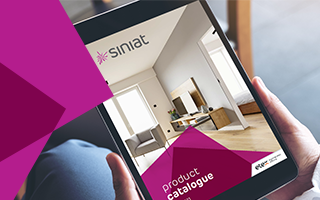Café and restaurant designers face a difficult challenge when designing café interiors: how to create buzz and ambience, while still letting people hear each other speak. Here are the key acoustic considerations.
There are no hard and fast acoustic rules for cafés and restaurants: as most strive to create a unique atmosphere and identity.
The target audience, the location, the space and the food are critical factors that the acoustic environment must align with. Catching dinner with friends after work, before a fun night on the town, requires a completely different atmosphere than does a romantic dinner for two, or a formal business dinner meeting. The sound needs to match the restaurant.
As a result, when designing the acoustics for café and restaurant interiors, it’s important to know as much as possible about what the restaurateur is trying to achieve. Will customers sit at long refectory tables or in small cosy alcoves, for instance?
With communal refectory tables, the hard surfaces and noise from other guests creates the atmosphere; ‘the buzz’, while alcoves can feel private and isolated, giving guests a sense of being in their own little world.
The problem is that today, café and restaurant acoustics are often unplanned and first tested and experienced on opening night. The trend away from soft furnishings to hard surfaces has created cafes and restaurants where sound is allowed to travel freely and reverberation times become excessively long. And with something called the Lombard Effect in play, noise levels in that kind of environment just keep rising.
YOUR CAFÉ OR RESTAURANT INTERIOR AND THE LOMBARD EFFECT
The Lombard effect is an acoustic phenomenon that causes people to alter their speech in noisy environments, such as in noisy restaurants. Diners speak loudly to be heard by their companions and in turn diners at neighbouring tables also turn up the volume in order to be heard over their neighbours. The process continues until decibel levels typically reach well over 80 dB.
MATERIALS INFLUENCE THE SOUND IN YOUR CAFÉ INTERIOR
The materials used in a space influence the ‘tone colour’. Large glass facades, hard floors and walls, bare tables and chairs reflect sharp, clear sounds, whereas soft materials such as seating upholstery, curtains or drapes, tablecloths, carpets or rugs produce a softer atmosphere with a ‘mushy’ sound.
The positioning of materials also influences the sound experience: the more protrusions there are, the more they can ‘colour’ the sound in the room.
While choosing materials and furniture for their acoustic impact is important, making sure they’re fit for purpose is too. Choices should reflect the type of food served and the eating habits of the patrons. If there is a high risk of spills, table coverings may result in high maintenance costs and hard, smooth surfaces may be preferable.
However, sound absorbing materials do not need to be restricted to traditional soft furnishings. Feature artwork can be created using materials that absorb sound; rugs can be hung on walls as decoration, rather than be placed on floors. Special sound absorbing linings and panels can be painted in any colour or printed with unique designs or images.
WHY SOUND ABSORPTION, SOUND DIFFUSION AND SOUND INSULATION ARE IMPORTANT IN YOUR CAFÉ INTERIOR
Calculating acoustics involves determining how much a material can absorb sound, known as its sound absorption coefficient (α). If a material’s sound absorption coefficient is 0 then it is totally reflective. If the sound absorption coefficient is 1, then the material is totally absorbing.
This ability of a material to absorb or reflect sound is typically different at different sound frequencies. This balance of sound absorption properties is critical when it comes to acoustic comfort in room spaces.
However, some materials not only have the ability to absorb and reflect sound - they also have the ability to diffuse or ‘spread’ sound. This is called sound diffusion and is related to the surface texture of a material.
A rough or uneven surface is a good sound diffuser. Sound waves that are reflected back from an uneven surface are spread out in many directions and this helps to dissipate or break down the sound energy.
As well as noise inside, noise pollution may also affect neighbouring residents or businesses and this means that adjoining walls, ceilings and floors are required to have the necessary sound insulation values. Sound insulation is the ability of an object to resist sound transmission through it. The greater the sound insulation, the less noise will be transmitted from inside the restaurant and outside to neighbours.
The use of high, sound insulating wall and ceiling systems minimises the transmission of noise between spaces and helps reduce background noise levels.
The amount of energy transmitted, as a ratio of the total energy, is known as the sound transmission coefficient (a non-dimensional value between 0 and 1), which translates into a sound reduction index, R-value, for the wall.
If a wall has a sound transmission coefficient of 0.01 i.e. it allows 1% of sound energy to be transmitted through it, then the sound reduction index (R), is 20dB. To achieve an R-value of 50dB, the wall must have a sound transmission coefficient of 10-5. That is, it should only allow 0.001% sound energy to pass through.







